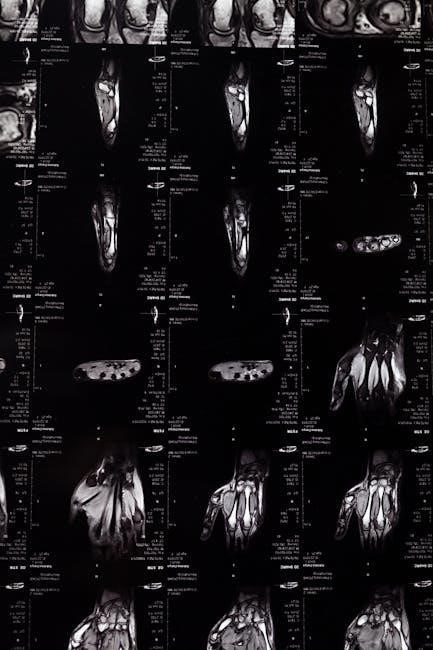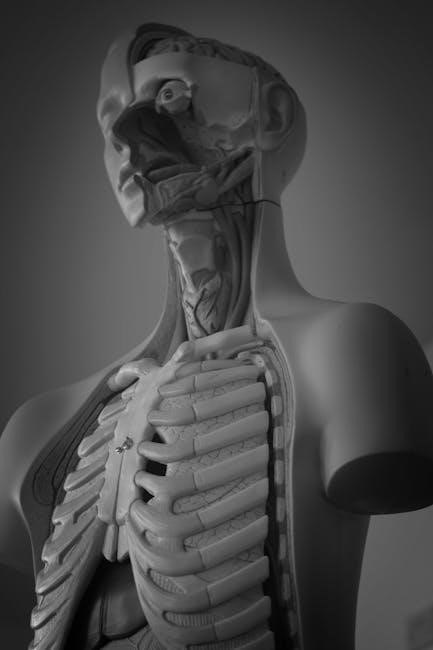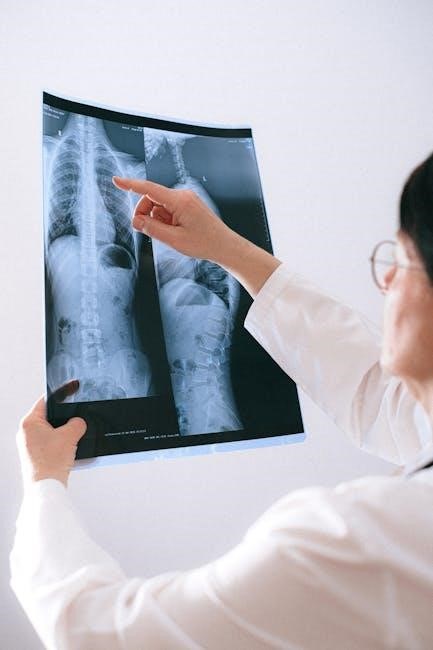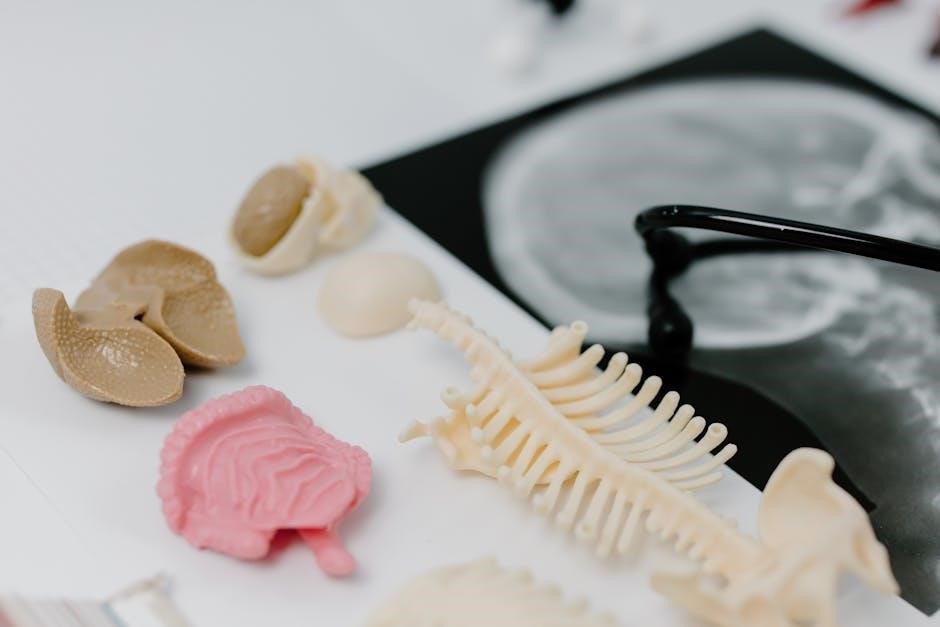Anatomy and physiology study guides simplify complex topics, enhance comprehension, and improve retention․ They offer visual aids, practice questions, and structured frameworks to master essential concepts effectively for students․
Understanding the Importance of Anatomy and Physiology
Anatomy and physiology form the foundation of understanding the human body and its functions․ Studying these subjects provides essential knowledge for healthcare professionals, scientists, and students in fields like medicine, nursing, and exercise science․ Anatomy focuses on the structure of body parts, while physiology explores their functions and interactions․ Together, they explain how the body maintains homeostasis, responds to stimuli, and adapts to changes․ Mastery of these concepts is crucial for diagnosing and treating medical conditions, as well as for advancing research in life sciences․ A strong grasp of anatomy and physiology also enables individuals to make informed decisions about health and wellness․ By understanding how the body works, students can better appreciate its complexity and interconnectedness, laying a solid base for further studies or professional practice․
Purpose of Study Guides in A&P
The primary purpose of anatomy and physiology (A&P) study guides is to simplify complex topics, making them easier to understand and master․ These guides provide structured frameworks that break down intricate concepts into digestible sections, often accompanied by visual aids like diagrams and illustrations․ They are designed to complement textbooks and lectures, offering additional practice questions, summaries, and interactive exercises․ Study guides help students identify and address knowledge gaps while reinforcing key terminology and processes․ They are particularly useful for visual learners, as they often include labeled images and flowcharts to explain physiological processes․ By focusing on high-yield information, A&P study guides enable learners to prioritize their study time effectively, ensuring they grasp essential concepts needed for exams and future professional applications․ They also serve as valuable tools for quick review and reference, helping students retain information long-term․
Key Features of Effective Study Guides
Effective anatomy and physiology (A&P) study guides are characterized by clear, concise explanations and a logical structure that aligns with course materials․ They often include high-quality visuals, such as detailed diagrams and labeled illustrations, to aid in understanding complex anatomical structures and physiological processes․ Practice questions, flashcards, and summary tables are common features that reinforce learning and retention․ Many guides also incorporate interactive elements, like quizzes or concept-check exercises, to engage students actively․ Additionally, the best study guides highlight key terminology and provide context for clinical applications, making the content more relevant․ They are designed to cater to different learning styles, ensuring that visual, auditory, and kinesthetic learners can benefit equally․ By focusing on essential concepts and providing opportunities for self-assessment, effective study guides help students build a strong foundation in A&P and prepare them for exams and real-world scenarios․
Basic Concepts in Anatomy and Physiology
Anatomy and physiology study guides introduce foundational concepts like levels of organization, anatomical terminology, and homeostasis․ These basics provide a framework for understanding the human body’s structure and functions effectively․
Levels of Organization in the Human Body
The levels of organization in the human body are a fundamental concept in anatomy and physiology, providing a structured way to understand how the body is arranged․ These levels range from the simplest to the most complex: cells, tissues, organs, organ systems, and the entire organism․ Cells are the basic building blocks, forming tissues that specialize in specific functions․ Tissues combine to create organs, which work together in organ systems to perform vital tasks․ Finally, all systems integrate to maintain the overall health of the organism․ Study guides often break down these levels visually, helping students grasp how each component interacts․ This hierarchical approach simplifies learning and highlights the interconnectedness of the body’s structures and functions, making it easier to comprehend complex physiological processes and their roles in maintaining homeostasis․

Basic Anatomy Terminology
Mastering basic anatomy terminology is essential for understanding the structure and function of the human body․ Common terms like anterior (front) and posterior (back) describe locations relative to the body․ Dorsal (toward the back) and ventral (toward the abdomen) are also key directional terms․ Students should familiarize themselves with terms like proximal (closer to the center) and distal (farther from the center) to describe positions along limbs․ Other important terms include superior (above) and inferior (below), used to describe vertical positions․ Understanding these terms helps in identifying body regions and movements, such as flexion (bending) and extension (straightening)․ Study guides often include flashcards and diagrams to aid in memorizing these terms, ensuring a strong foundation for further anatomical studies․
Physiology Basics: Homeostasis and Feedback Mechanisms
Homeostasis is the body’s ability to maintain a stable internal environment despite external changes․ It is achieved through feedback mechanisms, which regulate processes like temperature, blood sugar, and blood pressure․ Negative feedback reduces deviations from a set point, such as insulin lowering blood glucose levels․ Positive feedback amplifies changes, like oxytocin during childbirth․ Study guides often emphasize understanding these mechanisms through diagrams and examples, such as how the hypothalamus and pituitary gland regulate hormones․ Mastering these concepts is crucial for grasping how the body maintains balance and responds to disruptions․ Effective study guides provide clear explanations and practice questions to reinforce learning, ensuring students can apply this knowledge in clinical and laboratory settings․

Cellular and Tissue Structure
Study guides simplify understanding of cells, tissues, and their functions, using diagrams and summaries to explain membrane transport, tissue types, and their roles in maintaining bodily functions effectively․
Cell Membrane and Transport Mechanisms
The cell membrane, also known as the plasma membrane, is a thin, semi-permeable structure that regulates the movement of substances in and out of the cell․ Study guides often emphasize the fluid mosaic model, which describes the membrane’s structure as a fluid phospholipid bilayer embedded with proteins․ These proteins perform various functions, such as acting as receptors, channels, or transport molecules․ Transport mechanisms are categorized into passive transport (e․g․, diffusion, osmosis) and active transport, which requires energy․ Study guides typically include detailed diagrams and explanations to help students visualize how these processes work․ Practice questions and summaries are also provided to reinforce understanding of membrane structure and function, ensuring students can apply this knowledge in practical scenarios․ These resources are invaluable for mastering cellular physiology and preparing for exams․
Types of Tissues and Their Functions
In anatomy and physiology, tissues are groups of similar cells that perform specific functions․ There are four primary types of tissues: epithelial, connective, muscle, and nervous․ Epithelial tissue forms linings and glands, protecting surfaces and aiding in secretion or absorption․ Connective tissue supports and binds other tissues, providing structure and maintaining integrity, with examples like bone and blood․ Muscle tissue is specialized for contraction, enabling movement, such as skeletal muscles for voluntary actions or smooth muscles for involuntary functions like digestion․ Nervous tissue, found in the nervous system, facilitates communication through electrical and chemical signals, controlling body functions․ Study guides often include diagrams and tables to compare these tissues, helping students understand their roles and interactions within the body․ This foundational knowledge is crucial for advancing in A&P studies and applying concepts to real-world scenarios․
Epithelial, Connective, Muscle, and Nervous Tissues
Epithelial, connective, muscle, and nervous tissues are the four primary tissue types in the human body, each with distinct roles․ Epithelial tissues form protective barriers and linings, such as skin and mucous membranes, while connective tissues provide support, structure, and connectivity, including bone, cartilage, and blood․ Muscle tissues are responsible for movement, with skeletal muscles enabling voluntary actions and smooth muscles handling involuntary contractions, like digestion․ Nervous tissues specialize in communication, transmitting signals through neurons and glial cells․ Study guides often highlight these tissues’ unique characteristics and functions, using diagrams to illustrate their structures․ Understanding these tissues is fundamental for grasping how body systems interact and maintain overall health․ Effective study tools, such as labeled illustrations and comparison charts, help students master these concepts efficiently․

The Skeletal System
The skeletal system comprises bones and joints, providing support, protection, and movement․ Study guides simplify understanding of axial and appendicular skeletons, bone formation, and remodeling processes, enhancing learning․
Bones and Joints: Structure and Function
Bones and joints form the structural framework of the body, enabling movement and support; Study guides detail bone types, such as long, short, and flat bones, and their functions like protection and blood cell production․ Joints, classified as synovial, cartilaginous, or fibrous, facilitate varying degrees of motion․ Visual aids and 3D models in study guides help learners understand joint anatomy, including ligaments and tendons․ Key concepts like bone remodeling and joint stability are explained clearly, making complex processes accessible․ These resources also cover the role of bones in storing minerals and housing marrow․ By breaking down bone and joint structures into manageable sections, study guides enhance comprehension and retention, ensuring a strong foundation in skeletal system anatomy and physiology․
Axial and Appendicular Skeleton
The human skeleton is divided into two main systems: the axial and appendicular․ The axial skeleton, comprising 80 bones, includes the skull, vertebral column, ribs, and sternum, forming the body’s central axis․ It protects vital organs like the brain and organs in the thoracic cavity․ The appendicular skeleton, with 126 bones, consists of the upper and lower limbs, shoulders, hips, and pelvic girdles, enabling movement and locomotion․ Study guides often use detailed diagrams to illustrate the bones’ locations and functions․ They highlight how the axial skeleton provides stability, while the appendicular skeleton facilitates flexibility and mobility․ Understanding this classification is crucial for grasping human anatomy, as it forms the basis for studying the musculoskeletal system and its role in movement and support․
Bone Formation and Remodeling
Bone formation, or ossification, is the process by which bones develop and grow․ It involves the transformation of connective tissue into bone tissue through the action of osteoblasts, which secrete bone matrix․ Remodeling, on the other hand, is a continuous process where old bone tissue is replaced with new tissue, regulated by osteoclasts and osteoblasts․ This process maintains bone health, repairs microfractures, and ensures calcium homeostasis․ Study guides often emphasize the importance of understanding these processes, as they are fundamental to comprehending skeletal health and diseases like osteoporosis․ Visual aids, such as diagrams of bone cells and remodeling stages, are commonly used to simplify these complex biological mechanisms․ Additionally, key terms like “ossification” and “remodeling” are highlighted to reinforce memorization and facilitate deeper understanding of bone dynamics․

The Muscular System
The muscular system consists of skeletal, smooth, and cardiac muscles, enabling movement, maintaining posture, and facilitating bodily functions․ Study guides provide detailed insights into muscle structure, function, and coordination mechanisms for better understanding and retention of key concepts․
Types of Muscles: Skeletal, Smooth, and Cardiac
The muscular system comprises three primary types of muscles: skeletal, smooth, and cardiac․ Skeletal muscles are voluntary, attached to bones, and enable movement and posture․ Smooth muscles are involuntary, found in internal organs, and control functions like digestion․ Cardiac muscle is specialized for the heart, ensuring rhythmic contractions․ Study guides often detail these differences, emphasizing their unique structures, such as striations in skeletal and cardiac muscles, and the lack thereof in smooth muscles․ Understanding their roles and functions is crucial for grasping overall physiology․ Resources like AnatomyZone and The Noted Anatomist provide visual aids and summaries to help students master these concepts effectively, making complex information accessible and engaging for learners at all levels․
Muscle Contraction Mechanism
Muscle contraction occurs due to the sliding filament theory, where actin and myosin filaments slide past each other․ This process begins with a nerve impulse triggering the release of calcium ions from the sarcoplasmic reticulum․ Calcium binds to troponin, shifting tropomyosin and exposing myosin binding sites on actin․ Myosin heads then attach and pivot, pulling actin filaments toward the center of the sarcomere․ This action shortens the muscle fiber, leading to contraction․ ATP is essential for resetting myosin heads and terminating contraction․ Study guides often simplify this complex process with detailed diagrams and step-by-step explanations, helping students grasp the molecular mechanisms involved․ Resources like AnatomyZone and physiology textbooks emphasize the importance of understanding these dynamics for mastering muscle function and overall movement physiology․
Major Muscle Groups and Their Functions
The human body is composed of over 640 muscles, which are grouped based on their locations and functions; Major muscle groups include the muscles of the upper limb, lower limb, trunk, and head․ The upper limb muscles, such as the biceps and triceps, facilitate arm movements like flexion and extension․ Lower limb muscles, including the quadriceps and hamstrings, enable walking, running, and stability․ Trunk muscles, like the abdominals and back muscles, support posture and core movements․ Head muscles control facial expressions and jaw movements․ Study guides often provide detailed diagrams and charts to help students identify and memorize these groups․ Understanding their functions is crucial for grasping how the muscular system contributes to movement, balance, and overall physiology․ Effective study resources emphasize practical exercises to reinforce learning and retention of muscle group roles․

Nervous System Overview
The nervous system controls bodily functions, enabling sensory input, motor responses, and complex thought․ It consists of the central and peripheral nervous systems, working together to maintain homeostasis and regulate activities effectively․
Structure and Function of Neurons
Neurons, the fundamental units of the nervous system, consist of dendrites, a cell body, and an axon․ Dendrites receive signals, while the axon transmits them․ The cell body contains organelles essential for neuronal function․ Synapses, small gaps between neurons, allow chemical neurotransmitters to communicate signals․ This structure enables neurons to process and transmit information, facilitating sensory perception, movement, and thought․ Understanding neuron structure is crucial for studying nervous system functions and disorders, as highlighted in anatomy and physiology study guides․
Central and Peripheral Nervous Systems
The central nervous system (CNS), comprising the brain and spinal cord, processes information and controls voluntary and involuntary functions․ The peripheral nervous system (PNS), including sensory and motor nerves, connects the CNS to the body, enabling communication․ The CNS interprets sensory data and initiates responses, while the PNS transmits signals to and from the CNS․ Together, they regulate bodily functions, such as movement, sensation, and organ activity․ Understanding their roles is essential for grasping nervous system physiology․ Study guides often emphasize this distinction, providing detailed diagrams and explanations to help students master these concepts effectively․
Reflex Arc and Its Components
A reflex arc is a neural pathway that enables rapid, automatic responses to stimuli․ It consists of five key components: a sensory receptor, an afferent neuron, the central nervous system (CNS), an efferent neuron, and an effector․ The sensory receptor detects the stimulus, triggering nerve impulses that travel via the afferent neuron to the CNS for processing․ The CNS then sends signals through the efferent neuron to the effector, which executes the response, such as muscle contraction or gland secretion․ This mechanism allows for immediate reactions, often without conscious thought, ensuring survival and maintaining homeostasis․ Understanding the reflex arc is crucial for comprehending nervous system function and how the body responds to environmental changes․ Study guides often detail this process with diagrams and examples to enhance learning and retention․

Study Techniques for A&P
Effective study techniques for anatomy and physiology include active learning, spaced repetition, and detailed note-taking․ Utilize illustrations, practice questions, and digital tools to enhance understanding and retention of complex concepts efficiently․
Effective Note-Taking Strategies
Effective note-taking is crucial for mastering anatomy and physiology․ Start by actively summarizing complex topics in your own words, ensuring clarity and conciseness․ Use headings and bullet points to organize information, making it easier to review․ Highlight key terms and concepts with color or bold text to prioritize learning․ For anatomical structures, include sketches or diagrams alongside written notes to enhance visual retention․ Organize notes by systems or topics, such as skeletal or muscular systems, to maintain logical flow․ Regularly review and update your notes, filling in gaps and clarifying doubts․ Consistency is key; set aside dedicated time to refine your notes․ Incorporate digital tools if preferred, but keep the format simple and focused․ This structured approach ensures comprehensive understanding and efficient study sessions․
Active Learning Techniques
Active learning engages students beyond passive reading, enhancing retention and understanding․ Techniques include group discussions, practical lab sessions, and hands-on activities․ Create concept maps or flashcards to visually connect concepts․ Self-quizzing and teaching others also reinforce learning․ Use digital tools like quizzes or apps to test knowledge regularly․ Engage in problem-solving exercises, applying theoretical concepts to real-world scenarios․ Participate in study groups to debate and clarify complex topics․ Regularly review and discuss case studies to deepen comprehension․ Incorporate movement, such as labeling anatomical models, to combine physical and mental engagement․ These methods promote critical thinking and active participation, making learning dynamic and effective for anatomy and physiology․ Consistency and variety in active learning strategies ensure better retention and improved performance in exams and practical assessments․
The Role of Spaced Repetition in Retaining Information
Spaced repetition is a powerful strategy for retaining information in anatomy and physiology․ By reviewing material at increasing intervals, it helps move information from short-term to long-term memory․ This technique prevents the “forgetting curve” and ensures concepts remain accessible․ Utilize flashcards or apps like Anki to implement spaced repetition effectively․ Regular reviews strengthen memory traces, making complex topics easier to recall․ Consistency is key—spaced repetition should be part of a daily study routine․ It complements active learning and note-taking, reinforcing overall retention․ Over time, this method reduces study time while improving understanding and confidence in anatomy and physiology․ Incorporate spaced repetition into your study plan to master difficult subjects efficiently and retain knowledge long-term․